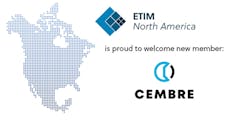“Just how old are you?” is rarely heard once past childhood. In fact, many of us work at hiding our age as the number increases. Vanity aside, knowing someone's age is a code giving us important information not only about the person but about their buying interests. Codes are widely used by business to categorize information, and provide stages, or maturity of products. Of the many code systems used in the electrical industry, those used for communicating update-process changes — adds, changes or deletes — are called “life-cycle” codes.
Several types of codes are in common use in electrical industry data. Some are industry standards and others are manufacturer-specific or proprietary. Examples of industry codes are unit of measure or currency codes where “USD” is for U.S. dollars and “CAD” is for Canadian dollars. Industry codes for product categorization and proprietary codes for product categorization have been around for years. Some of these codes are available only from selective updating service providers (including IDEA's Industry Data Warehouse (IDW), Trade Service Corp. and Material Express) and distributors choose the system that best suits their requirements.
The life-cycle code is required by distributors before they can use event-driven changed price and product data for loads and updates. Three summarized activity states are shown below:
- Active (encompasses several codes used by different update service providers).
- UPC (GTIN) changes.
- Retirement (encompasses several codes used by different update service providers).
This field is important because much of data's relevancy is based on a comparison of the new data to the previous. Companies using the data will depend on the values found in their updating service providers' code system. This attribute, while called “item status” or “change flag” depending on the updating service, is actually a life-cycle code because it identifies actual product life-cycle changes at the stock-keeping unit (SKU) level. The fact that different updating services call the attribute by different names or that the character codes are different is not an inhibitor for distributors, because all of popular distributor ERP (enterprise resource planning) software is designed to handle these different names. Product life-cycle is a discipline usually found within the manufacturers' marketing department and represents the products' life span of launch, growth, maturity and decline.
Notification of retired products
Manufacturers analyze sales during the product's life span to determine the exact point when it's no longer profitable to continue to offer that product, and from this point the obsolescence process begins. If the manufacturers' return or obsolescence process does not provide a retirement life-cycle code for those products in their changed-data update file sent to update service providers, then the return process will be lengthened, expensive and complex. Also, there's a greater chance of marring a good supplier/distributor relationship when distributors' requests to return products cannot be honored because the return window has expired.
Publishing event-driven data changes
For a streamlined, automatic process, manufacturers must send event-driven data changes to update service providers with the life-cycle codes populated and all other necessary attributes. Only then will we have information that's easily incorporated into actionable data by all segments of the supply chain.
However, manufacturers aren't always providing that data in the correct format. These are the common problems:
-
Manufacturers do not include the life-cycle codes in their event-driven data changes to update service providers.
-
Life-cycle code changes are not made at the same time as the products' life-cycle changes.
-
Once the first state of “active” is sent, there are no updates to the life-cycle code, even as the product goes into the retirement state.
The result is extra work for the entire supply chain, including manufacturers, who will experience a more difficult and expensive phase-out process for those products.
Once product data is loaded into distributors' databases, those items are place-holders representing inventory value. Distributors will not delete or remove these items from their database until they are positive inventory is depleted and all activity has been suspended. It may still be another one-to-two years before items are purged from the distributors' product database, so it's easy to see why life-cycle codes are so important for inventory management.
How automation creates more selling time
Because of the large quantities of data that companies deal with today, it's more important than ever before to have SKU-level, event-change notifications. Gordon Electric Supply, Kankakee, Ill., a 57-year-old company with a focus on heavy-contractor and light-industrial work, finds it easy to maintain its product inventory pricing by using an Eclipse ERP system with weekly updates from an updating service that handles all changes automatically. JoAnn Ford, product manager, says the company first checks its weekly reports and then loads the changes occurring that week from selected manufacturers into its Eclipse Product Data Warehouse (PDW). These changes include price increases and decreases, as well as UPC and catalog number changes or products flagged with retirement codes of “D” and “Q” that will be removed eventually from their database. Ford says these products are purged from the master database twice a year after checking to ensure inventory is depleted. “It's easy because it's all automated,” she says.
This is one of those times when no news is good news. The company's SHIMS (Supply House Inventory Management System) uses weekly or periodic downloads from an update service provider to update the change flags to reflect the price changes and help them manage their product inventory, particularly for those items flagged as discontinued by the manufacturer.
According to Jim Morlan, CEO of Electric Supply Inc., a 58-year-old company located in Phoenix, Ariz., with a focus on heavy-commercial, light-residential, industrial, MRO and government work, “We can and do manually select out items with the ‘D’ or deleted (retirement) code to see what we want to do with them. If we have a customer who prefers this item, then we might quickly order more and help the manufacturer deplete their inventory, giving us more time to find the right substitute product to satisfy our customer. These tools help us keep the right inventory in stock and grow our business.”
Linking old to new products
Maintaining UPC/GTIN number integrity is very important because this is the identity key for individual products within the distributors' database. Providing all of the right attributes to make UPC/GTIN (Global Trade Item Number) changes is one of the three critical product life-cycle states noted above. North Coast Electric Co., Seattle, a 97-year -old company doing commercial, industrial and residential work, depends on manufacturers correctly populating the primary key fields. When changes occur to either the UPC or the catalog number attributes, the cross-references from the older identity keys to the new identity keys (UPC/GTINS) — with change flags of “C” and “R” for Change and Replace, respectively — are crucial to automated data management. It's easy to understand the importance of this change-out when it impacts not just employee lookups but also directs traffic to match up newly loaded net pricing to existing database items with customers receiving the merged product and pricing information.
“Some manufacturers are doing a good job in populating the multiple levels of retirement change flags. This automates the process for them to review and approve those changes using their Eclipse ERP system and reporting tools resulting in preventive medicine,” says Chris Carter, North Coast Electric's director of marketing services. “The ‘O’ for ‘obsolete’ change flag indicates retirement of a product by the manufacturer. When the replacement or superseded item is populated in the data instead of ending the life-cycle, it actually ends up redirecting sales to the newer item and keeps our stocks of the right products at optimum levels to satisfy our customers' requirements.”
Converting codes into actions
How the change codes work within a distributor's ERP system is as important as the codes themselves. An example of this is the seamless UPC change, which includes transferring the sales history from the old-UPC item to the newly created item. This saves a great deal of labor because items aren't handled manually. “Knowing what changed before initiating the changes is also important,” says John Milotte, general manager, Dulles Electric Supply Inc., Sterling, Va., a 25-year-old full-service supply house serving the commercial, industrial, governmental and residential markets. “We first check our weekly update summary reports for proposed changes. By checking the counts following the update, it provides a quality check on our data process.”
Impacts of early retirement (codes)
Wabash Electric Inc., Wabash, Ind., a 50-year-old company, services customers in the heavy-industrial, commercial construction and light-residential markets. To keep their pricing and product information up-to-date, they take advantage of weekly downloads from the IDW. Wabash Electric is a strong proponent of data synchronization via the IDW, and John Forrester, CEO and president, served on the IDEA Board of Directors from 2006 to 2008.
Using the “item status” life-cycle attribute within their Prophet 21 ERP system is an important part of their inventory management, but there have been some problems. Forrester says the greatest difficulty his company has encountered is that sometimes items appear to be flagged too early as retired or obsolete. In these cases, items can still be purchased and more problematic, manufacturers are still updating pricing for these items. Many distributor ERP software programs react to retire life-cycle codes with the following actions:
-
Warning the purchasing department with alerts or reports to not buy more.
-
Freezing cost of goods and resale pricing.
-
Warning the sales department to sell remaining inventory quickly. This might require reducing sell prices.
-
Staff spends time finding replacements for obsolete items popular with their customers.
-
Customers are told products are retired and cannot be purchased.
“It ends up being a lot of lost time and sometimes results in a lost sale or customer instead of helping prevent that,” says Forrester. “Also, there could be lost revenue if resell prices are frozen but the cost increases from an update, and this might not be caught until after the sale is made.
“What we now do is suspend the software from reacting automatically to any retirement codes and wait until we hear back from the purchasing department when that product can no longer be purchased. We don't want to react prematurely.”
One of the follow-up activities performed once an item is flagged as retired by the manufacturer is to return or sell off the remaining inventory.
Data management at the source
For VMI (vendor managed inventory), special care must be taken to fully understand and integrate the manufacturer's inventory, returns and sales policies with the distributors' inventory, returns and sales policies. Why? Because the distributor will sell more product and both will benefit. Some manufacturers still think it's okay to provide data to updating services that only includes pricing updates. But these suppliers don't fully understand the importance of the life-cycle codes and the role these codes play to help the distributor better manage their inventory and sell more products.
“VMI appears to be used as a substitute for maintaining timely and accurate obsolescence data fields in data provided to the IDW or updating services,” says Wabash Electric's Forrester. “In the end, this doesn't help the distributor against customer returns of obsolete product when data fields are not being populated correctly.”
Optimizing with the right codes
Volumes of data and frequency of changes provide many challenges to the distributors using data to run their business. Dave Pratt, CIO at Vanguard National Alliance, Natick, Mass., says his firm uses SX Enterprise ERP software to provide national account sales and service for the Rockwell Automation distributor locations throughout the U.S. and Canada. “Proper use of the life-cycle codes benefits the supply-chain side of a distributor business by providing critical information on how and what we choose to buy, receive and ship,” he says. “These codes help to guide the salesperson or web buyer to updated or replacement product if a selected product is no longer active. Staying in step with good manufacturer data should lead to optimization of inventory investment while working to reduce waste and returned products.”
Summary
Providing the life-cycle codes ensures that the distributors' ERP system processes the SKU-level data changes in coordination with the product's life-cycle in the distributors' inventory. It's a vital tool for ensuring excellence in business operations for manufacturers and distributors.
Beth Badrakhan is a data consultant with 35 years of experience in the electrical industry. She has worked with U.S. and Canadian manufacturers, distributors and contractors on data content, quality, life-cycle, integration and standards. She was formerly employed by IDEA as IDW data manager for nine years. She also has worked for two electrical distributors and the service provider Trade Service Corp. for seventeen years in data operations and administration. She can be reached at [email protected].








